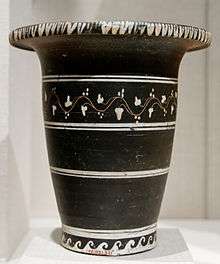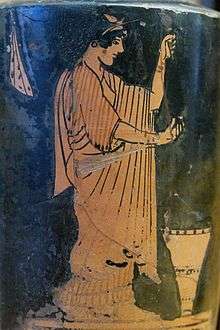Kalathos

A kalathos (Ancient Greek: κάλαθος, plural kalathoi κάλαθοι) is a vase in the form of a top hat, used to hold wool or fruit, often used in ancient Greek art as a symbol of abundance and fertility.[1][2]
The word kalathos means a basket, usually with a narrow base and a flared top. The decoration on some of these containers is taken to imitate the woven texture of a basket. This can be achieved by a painted design, but many kalathoi have open-work cut into their sides [3] and some have impressed decoration. Kalathoi may occur with or without handles. In both the Greek and Roman worlds these baskets had many uses, but were especially associated with wool working and the harvest.[4]

The kalathos is principally a multifunctional basket. Literary sources report that, depending on the context, the kalathos could contain wool, but also food (bread, cheese, milk, fruits and vegetables), small animals or flowers. The kalathoi were most often made of willow rods, but other examples made from clay, metal, glass and stone are also known. A silver kalathos with a golden rim is mentioned by Homer as belonging to Helen, this one even ran on wheels. Kalathoi are also depicted on Greek vases in other contexts. Illustrations on south-Italian vases make use of the kalathos as a symbol of a future marital relationship.[5]
In Cyprus, a fragmentary figurine of a woman wearing a crown (polos in the shape of a kalathos) has been identified as Aphrodite. Similar crowned limestone heads have been found all over the island. The kalathos has traditionally been interpreted as a fertility symbol, reserved for goddesses or their priestesses.[6]
References
- ↑ "Definition of Kalathos". Dictionary.com. Retrieved 2014-01-24.
- ↑ "Black-figure kalathos". Museo Galileo. Retrieved 2014-01-24.
- ↑ An example of this type can be seen in the British Museum Collections
- ↑ Peter Connor; Heather Jackson (2000). Greek Vases at The University of Melbourne. p. 30. ISBN 1-876832-07-X.
- ↑ Mary Harlow; Marie-Louise Nosch, ed. (2014). Greek and Roman Textiles and Dress. pp. 190–203. ISBN 978-1-78297-715-5.
- ↑ Giorgos Papantoniou (2012). Religion and Social Transformations in Cyprus. pp. 243–244. ISBN 978-90-04-22435-3.
External links
| Wikimedia Commons has media related to Kalathoi. |
- Kalathos from Kalymnos 1130BC-1090BC, British Museum
- Kalathos : The Collaborative Numismatics Project
- Mycenaen Ceramic Kalathos, Phoenix Ancient Art